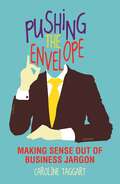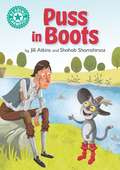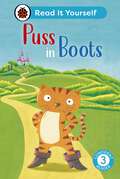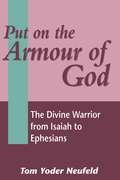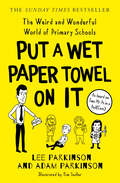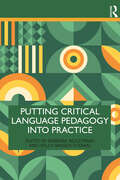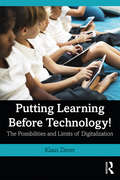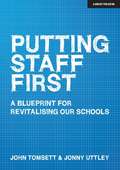- Table View
- List View
Pushing the Envelope: Making Sense Out of Business Jargon
by Caroline TaggartThe bottom line is this: the workplace is a minefield of business jargon that people bandy about on a daily basis. From indecipherable abbreviations and business terminology, to buzz words, motivational phrases and more, it can all start to sound like everyone around you is speaking another language. But it's time to shoot the puppy (do the unthinkable), push the envelope (expand the boundaries), knife and fork the problem (handle bit by bit), and get to grips with the language of business! Pushing the Envelope, takes a wry and witty look at office jargon, uncovering the origins and meanings of many useful - and some not so useful - phrases that can be heard in the workplace and in everyday life. Amusing and informative, this book guarantees that you'll be fluent in business in no time.
Pushing the Frontier: A Cohesive System-wide Approach to Integrating ICT into Education
by Seng Chee Tan Horn Mun Cheah Wenli Chen Doris ChoyThis book focuses on the integration of information and communication technologies (ICT) into K-12 education. It documents the authors’ reflections on the approaches and issues that have facilitated implementation of ICT integration in education as well as their experience in integrating ICT in education at multiple levels – policies that empower schools; learning environments that encompass the hardware, services and support systems; school-based teaching and learning frameworks; research and development of ICT-enabled pedagogies and innovative professional development models.
Puss in Boots: Independent Reading Turquoise 7 (Reading Champion #596)
by Jill AtkinsThe miller's son is very poor, but he has an incredible talking cat, and Puss is determined to be rich!This story is part of Reading Champion, a series carefully linked to book bands to encourage independent reading skills, developed with Dr Sue Bodman and Glen Franklin of UCL Institute of Education (IOE)Reading Champion offers independent reading books for children to practise and reinforce their developing reading skills.Fantastic, original stories are accompanied by engaging artwork and a reading activity. Each book has been carefully graded so that it can be matched to a child's reading ability, encouraging reading for pleasure.
Puss in Boots: Read It Yourself - Level 3 Confident Reader (Read It Yourself)
by LadybirdBased on the classic fairy tale. When a miller's son is left a cat by his father, he is shocked to find that Puss in Boots can talk - and not only that, Puss has a plan for helping the miller's son find happiness.Puss in Boots is from Confident Reader Level 3 and is perfect for more confident readers aged from 6+ who can read simple stories with help.Each book has been carefully checked by educational and subject consultants and includes comprehension puzzles, book band information, and tips for helping children with their reading.With five levels to take children from first phonics to fluent reading and a wide range of different stories and topics for every interest, Read It Yourself helps children build their confidence and begin reading for pleasure.
Put on the Armour of God: The Divine Warrior from Isaiah to Ephesians (The Library of New Testament Studies #140)
by Thomas Yoder NeufeldIsaiah 59 portrays a deity in armour warring against rebellious human foes. In this historical investigation, Yoder Neufeld maps the transformation of an ancient tradition into a creative new reading in which God's people put on God's armour and go to battle against God's heavenly foes, as in Ephesians 6. The Pauline recasting of the Isaianic motif, argues the author, is a bracing one.
Put Thinking to the Test
by Lori Conrad Missy Matthews Cheryl Zimmerman Patrick A. AllenHow can teachers use the comprehension strategies put forward in books like Strategies That Work and Mosaic of Thought to help students become not just better readers and thinkers but also better test takers? The four authors of Put Thinking to the Test have spent years pursuing that question and have developed a groundbreaking approach, as their colleague Ellin Keene writes in the foreword to the book:
Put Thinking to the Test
by Lori Conrad Missy Matthews Cheryl Zimmerman Patrick A. AllenHow can teachers use the comprehension strategies put forward in books like Strategies That Work and Mosaic of Thought to help students become not just better readers and thinkers but also better test takers? The four authors of Put Thinking to the Test have spent years pursuing that question and have developed a groundbreaking approach, as their colleague Ellin Keene writes in the foreword to the book:
Put A Wet Paper Towel on It: The Weird And Wonderful World Of Primary Schools
by Lee Parkinson Adam ParkinsonA heart-warming and hilarious look at life in the classroom from the teachers who host the most popular UK education podcast, Two Mr Ps in a Pod(Cast).
Putting Assessment for Learning into Practice (Ideas in Action)
by David SpendlovePutting Assessment for Learning into Practice is about the purpose of teaching and assessment as a means to ensuring deep, maximised, engaged and challenging learning. The simple message is good teaching can overcome bad testing and central to assessment for learning is empowering learners through developing learning autonomy. This means involving learners in their own learning through reflection but also as co-constructors and co-negotiators of their learning. This book is for all teachers and school leaders who are committed to ensuring learners are engaged in successful, meaningful and deep learning. Effective strategies based upon good practice are identified which place teachers and learners as central to the process of owning and adapting their teaching and learning.
Putting Crisis in Perspective: Analyses of Past and Present Crises in Literature, Culture, and Foreign Language Teaching (Second Language Learning and Teaching)
by Artur SkweresThis collected book analyzes the phenomenon of crisis manifested across various historical periods. It offers unique, multifaceted, and interdisciplinary perspectives on the issues of crises and finds numerous applications in the fields of literature, linguistics, advertising, photography, and foreign language teaching. The collection is divided into two parts. The chapters in its first part analyze literature and language: from medieval England to cultural changes in America occurring under the influence of the transformation caused by the propagation of print culture. The incisive commentaries consider the works of culture that span not only literature but also film. They reveal how much we can learn by considering how past generations perceived reality in times of crisis. The second part of the book contains chapters, which examine texts related to contemporary crises expressed in the visual media of advertising and photography, but also in foreign language teaching. As the authors show, both ads and non-commercial, socially engaged photographs can influence the viewer in a swift and impactful manner by conveying messages of great social importance. The authors convincingly that argue both photographs and ads can be used for social benefit by visualizing even the unpleasant or shocking sides of reality. Finally, the notion of crisis experienced by students of English as a foreign language is analyzed and supplemented by research which may prove useful for researchers and practitioners alike.
Putting Critical Language Pedagogy into Practice
by Barbara Muszyńska Holly Hansen-ThomasPutting Critical Language Pedagogy into Practice explores the practice of language teaching through the lens of critical pedagogy, reflexivity, and the importance of reflexivity for teacher development. It also shows how these reflexive practices can contribute to more inclusivity and decolonization of the curriculum. A range of experts argue persuasively for epistemological reflexivity in practice and demonstrate how to implement this critical thinking into daily instructional practice. Each chapter is structured around three themes in order to help readers connect challenging theoretical ideas into day to day teaching practice: Reflection – the author’s story and issue of concern; Epistemic Reflexivity – personal epistemologies reflecting on the social conditions influencing the theory underpinning that author’s practices; Resolved action – how the epistemic reflexivity leads to purposeful decision-making enacted in classroom contexts. Original, thoughtful and challenging, this text is fascinating and instructional reading for language education advanced students, researchers and practitioners. The idea for this book emerged during the Fulbright scholarship at Texas Woman’s University out of the mutual research interests of the editors.
Putting Critical Language Pedagogy into Practice
Putting Critical Language Pedagogy into Practice explores the practice of language teaching through the lens of critical pedagogy, reflexivity, and the importance of reflexivity for teacher development. It also shows how these reflexive practices can contribute to more inclusivity and decolonization of the curriculum. A range of experts argue persuasively for epistemological reflexivity in practice and demonstrate how to implement this critical thinking into daily instructional practice. Each chapter is structured around three themes in order to help readers connect challenging theoretical ideas into day to day teaching practice: Reflection – the author’s story and issue of concern; Epistemic Reflexivity – personal epistemologies reflecting on the social conditions influencing the theory underpinning that author’s practices; Resolved action – how the epistemic reflexivity leads to purposeful decision-making enacted in classroom contexts. Original, thoughtful and challenging, this text is fascinating and instructional reading for language education advanced students, researchers and practitioners. The idea for this book emerged during the Fulbright scholarship at Texas Woman’s University out of the mutual research interests of the editors.
Putting Design Thinking to Work: How Large Organizations Can Embrace Messy Institutions to Tackle Wicked Problems (Understanding Innovation)
by Christoph Meinel Steven NeyThis book discusses how the methods and mindsets of design thinking empower large organizations to create groundbreaking innovations. Arguing that innovations must effectively tackle so-called “wicked problems,” it shows how design thinking enables managers and innovators to create the organizational spaces and practices needed for breakthrough innovations. Design thinking equips actors with the tools and methods for harnessing the creative tensions inherent in pluralist, often conflicting disciplinary approaches. This, however, requires the transformation of contemporary organizational cultures away from monolithic, integrated models (or identities) toward more pluralist, dynamic and flexible institutional identities. Based on real-world cases from a wide range of organizations around the globe, the book offers managers and innovators practical guidance on initiating and managing the cultural transformations required for effective innovation.
Putting Knowledge to Work and Letting Information Play: Second Edition (Transdisciplinary Studies #4)
by Timothy W. Luke Jeremy HunsingerThese collected papers are critical reflections about the rapid digitalization of discourse and culture. This disruptive change in communicative interaction has swept rapidly through major universities, nation states, learned disciplines, leading businesses, and government agencies during the past decade. To commemorate the tenth anniversary of the Center for Digital Discourse and Culture (CDDC) at Virginia Tech, which has been a pioneering leader for many of these changes in university settings, the contributors to this volume examine the transformative implications of digitalizing discourse and culture inside and outside of the academic arena. These technologies of digitalization have created new communities of users, which are highly engaged with their new communicative possibilities, informational content, and discursive forms. Few have asked what these changes will mean, and many of the most important voices engaged in debates about this critical transformation are gathered here in this volume. Each author in his or her own way considers what accepting digital discourse and informational culture now means for contemporary economies, governments, and societies.
Putting Learning Before Technology!: The Possibilities and Limits of Digitalization
by Klaus ZiererFor many, digitalization is the key to revolutionizing education. But what do we know about its impact on the learning process? What benefits are on offer and what are the risks? What are the consequences for educational interventions? Putting Learning Before Technology! discusses these questions and more in a thorough exploration of the use of technology in educational settings. Central to the author's argument is that digitalization as a sole and structural measure will bring little benefit and that the teachers who bring lessons to life are much more important. Features of the book include: evidence from Visible Learning research to scientifically frame the effectiveness and pitfalls of technology in the classroom; real-life classroom examples; graphics to clearly illustrate key concepts and studies. This book is a fascinating analysis of the impact, possibilities, and limits of the use of technology within education, and will appeal to teachers and teacher-trainers in any setting or country.
Putting Learning Before Technology!: The Possibilities and Limits of Digitalization
by Klaus ZiererFor many, digitalization is the key to revolutionizing education. But what do we know about its impact on the learning process? What benefits are on offer and what are the risks? What are the consequences for educational interventions? Putting Learning Before Technology! discusses these questions and more in a thorough exploration of the use of technology in educational settings. Central to the author's argument is that digitalization as a sole and structural measure will bring little benefit and that the teachers who bring lessons to life are much more important. Features of the book include: evidence from Visible Learning research to scientifically frame the effectiveness and pitfalls of technology in the classroom; real-life classroom examples; graphics to clearly illustrate key concepts and studies. This book is a fascinating analysis of the impact, possibilities, and limits of the use of technology within education, and will appeal to teachers and teacher-trainers in any setting or country.
Putting PIRLS to Use in Classrooms Across the Globe: Evidence-Based Contributions for Teaching Reading Comprehension in a Multilingual Context (IEA Research for Educators #1)
by Marian Bruggink Nicole Swart Annelies van der Lee Eliane SegersThis open access book provides teachers with approaches to strengthen reading comprehension instruction based on scientific research and evidence-based didactic principles. In this volume, the Progress in International Reading Study (PIRLS) framework is used to inform teachers about the skills and knowledge that students need to comprehend certain texts. The book gives practical guidance on how a teacher can help students to learn these skills, specifically, when teaching reading to multilingual students. Good practices from schools in five participating PIRLS countries—Chile, Chinese Taipei, England, Georgia, and Spain—are shared. A description of the schools’ education in reading comprehension is provided with practical tips and example lessons. These insights into daily reading education in multilingual classrooms across the globe can be an inspiration to teachers all over the world.
Putting Process Drama into Action: The Dynamics of Practice
by Pamela Bowell Brian S. HeapThis new book provides a clear and accessible guide on best practice to support teachers when using process drama in establishing creative learning partnerships with their students. It offers a detailed analysis and explores the roles of actor, director and playwright that the teacher must adopt in order to develop the ‘thinking on your feet’ skills and knowledge necessary to deliver a complete process drama experience. Addressing the dynamic nature of process drama, it provides a clear and rigorous explanation of the theory of process drama and links it to practice. Drawing on a wide range of detailed examples from the authors’ international and cross-cultural practice, it demonstrates how an effective process drama operates in action. Written to help practitioners and students produce powerful, artistic and educative experiences, chapters cover: pedagogy and the improvised nature of the art form; the structural framework and making shifts in the drama; the role of actor, director, playwright and teacher; monitoring emotional range; progression and the importance of reflection; the spiral of creative exchange and the complexities of co-creativity. Putting Process Drama into Action will be an essential guide for students undertaking initial teacher training at primary level, in addition to those studying both Drama and English at secondary level. It will also prove to be essential reading for specialist and non-specialist teachers in the primary and secondary sectors who teach, or wish to teach, process drama.
Putting Process Drama into Action: The Dynamics of Practice
by Pamela Bowell Brian S. HeapThis new book provides a clear and accessible guide on best practice to support teachers when using process drama in establishing creative learning partnerships with their students. It offers a detailed analysis and explores the roles of actor, director and playwright that the teacher must adopt in order to develop the ‘thinking on your feet’ skills and knowledge necessary to deliver a complete process drama experience. Addressing the dynamic nature of process drama, it provides a clear and rigorous explanation of the theory of process drama and links it to practice. Drawing on a wide range of detailed examples from the authors’ international and cross-cultural practice, it demonstrates how an effective process drama operates in action. Written to help practitioners and students produce powerful, artistic and educative experiences, chapters cover: pedagogy and the improvised nature of the art form; the structural framework and making shifts in the drama; the role of actor, director, playwright and teacher; monitoring emotional range; progression and the importance of reflection; the spiral of creative exchange and the complexities of co-creativity. Putting Process Drama into Action will be an essential guide for students undertaking initial teacher training at primary level, in addition to those studying both Drama and English at secondary level. It will also prove to be essential reading for specialist and non-specialist teachers in the primary and secondary sectors who teach, or wish to teach, process drama.
Putting Research into Practice in Primary Teaching and Learning
by Suzi Clipson-Boyles Graham UptonFirst Published in 2000. Routledge is an imprint of Taylor & Francis, an informa company.
Putting Research into Practice in Primary Teaching and Learning
by Suzi Clipson-Boyles Graham UptonFirst Published in 2000. Routledge is an imprint of Taylor & Francis, an informa company.
Putting Staff First: A Blueprint For Revitalising Our Schools (PDF)
by John Tomsett Jonny UttleyIf we do not ensure, first and foremost, that our teachers are happy, healthy, well qualified, highly motivated, hard-working, well-trained experts, they cannot be their best for their students. Consequently, a school which does not prioritise professional learning and managing staff workload which, as a consequence, will help improve staff wellbeing is disadvantaging its own students. Whilst it is easy to say that schools would not exist if it were not for the students, the glib converse is that without truly great school staff, the students would not be taught well enough. What we need as recruiting subject specialist teachers, school leaders and specialist support staff becomes increasingly difficult is a revolution in how we treat the adults in schools. 'What is the most important school-related factor in pupil learning? The answer is teachers', say Schwartz et al, and if they are correct, then we have to put our staff first because it is the only hope we have of securing what our students need most: top quality teachers (Schwartz et al, 2007). And whilst we are determined to put staff first, that does not mean working in a blueprint school is an easy ride; far from it. We expect teachers to work hard and to be the best version of themselves they can possibly be. If high quality teaching is the only thing that really matters when it comes to improving students outcomes, it follows, then, that we expect teachers in blueprint schools to accept the professional obligation to improve their practice; indeed, we consider that to be one of the most important aspects of being a teacher in a blueprint school. The leadership wisdom you might find in this book is neither dogmatically based upon educational research evidence nor is it solely derived from our experience; it is a synthesis of both. What is common to everything we propose in our blueprint is that we unapologetically put staff first. The Cambridge Dictionary defines a blueprint as an 'early plan or design that explains how something might be achieved'. Ten years after the Academies Act disrupted the structures of the English school system irrevocably, we want to look forward ten years hence, to a revitalised school system where our nation's teachers are thriving and, consequently, so are our students. What follows is a 2030 blueprint to revitalise our schools that unashamedly puts staff first.
Putting Staff First: A blueprint for a revitalised profession
by John Tomsett Jonny UttleyIf we do not ensure, first and foremost, that our teachers are feeling physically and mentally well, they cannot be their best for their students. Consequently, a school which does not prioritise staff wellbeing is disadvantaging its own students. 'Students first' is a misplaced sentiment: the best thing for students is a happy, healthy, motivated, well-trained, expert staff. By putting staff first you are providing for students the one thing which will help them make good progress in their learning: truly great teaching. Whilst it is easy to say that schools would not exist if it were not for the students, the glib converse is that without truly great school staff, the students would not be taught. What we need - as recruiting subject specialist teachers, school leaders and specialist support staff becomes increasingly difficult - is a revolution in how we treat our school staff. We have to put our staff before our students because it is the only hope we have of securing what our students need most: a world class education. The longer our schools are populated with hypoxic adults, we imperial all our futures. What follows is a blueprint for the school system which puts our school staff before students.
Putting Storytelling at the Heart of Early Childhood Practice: A Reflective Guide for Early Years Practitioners
by Tina Bruce Lynn McNair Jane WhinnettPutting Storytelling at the Heart of Early Childhood Practice is a brilliantly engaging and practical book that highlights the essential nature of storytelling in all walks of life, and how to best cultivate this in the early years classroom. The authors use a compelling Froebelian approach to explore the role of storytelling not just in the development of literacy but also in the development of communication and language and for maintaining good mental health and wellbeing. Drawing on primary and contemporary research, and presented by a range of experienced authors, this book covers important topics such as: The benefits of regularly practising storytelling Storytelling during play activities Group dynamics in constructing narratives The roles of props and fantasy concepts in storytelling This accessible guide is ideal for all early years practitioners looking to encourage literacy, communication and well-being in a supportive and creative environment, and for policymakers looking to develop best practice in the early years classroom.
Putting Storytelling at the Heart of Early Childhood Practice: A Reflective Guide for Early Years Practitioners
by Tina Bruce Lynn McNair Jane WhinnettPutting Storytelling at the Heart of Early Childhood Practice is a brilliantly engaging and practical book that highlights the essential nature of storytelling in all walks of life, and how to best cultivate this in the early years classroom. The authors use a compelling Froebelian approach to explore the role of storytelling not just in the development of literacy but also in the development of communication and language and for maintaining good mental health and wellbeing. Drawing on primary and contemporary research, and presented by a range of experienced authors, this book covers important topics such as: The benefits of regularly practising storytelling Storytelling during play activities Group dynamics in constructing narratives The roles of props and fantasy concepts in storytelling This accessible guide is ideal for all early years practitioners looking to encourage literacy, communication and well-being in a supportive and creative environment, and for policymakers looking to develop best practice in the early years classroom.
